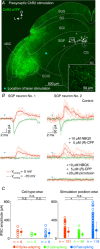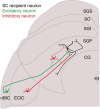Complex and spatially segregated auditory inputs of the mouse superior colliculus
- PMID: 30206945
- PMCID: PMC6209754
- DOI: 10.1113/JP276370
Complex and spatially segregated auditory inputs of the mouse superior colliculus
Abstract
Key points: Although the visual circuits in the superior colliculus (SC) have been thoroughly examined, the auditory circuits lack equivalent scrutiny. SC neurons receiving auditory inputs in mice were characterized and three distinguishable types of neurons were found. The auditory pathways from external nuclei of the inferior colliculus (IC) were characterized, and a novel direct inhibitory connection and an excitation that drives feed-forward inhibitory circuits within the SC were found. The direct excitatory and inhibitory inputs exhibited distinct arbourization patterns in the SC. These findings suggest functional differences between excitatory and inhibitory sensory information that targets the auditory SC.
Abstract: The superior colliculus (SC) is a midbrain structure that integrates auditory, somatosensory and visual inputs to drive orientation movements. While much is known about how visual information is processed in the superficial layers of the SC, little is known about the SC circuits in the deep layers that process auditory inputs. We therefore characterized intrinsic neuronal properties in the auditory-recipient layer of the SC (stratum griseum profundum; SGP) and confirmed three electrophysiologically defined clusters of neurons, consistent with literature from other SC layers. To determine the types of inputs to the SGP, we expressed Channelrhodopsin-2 in the nucleus of the brachium of the inferior colliculus (nBIC) and external cortex of the inferior colliculus (ECIC) and optically stimulated these pathways while recording from SGP neurons. Probing the connections in this manner, we described a monosynaptic excitation that additionally drives feed-forward inhibition via circuits intrinsic to the SC. Moreover, we found a profound long-range monosynaptic inhibition in 100% of recorded SGP neurons, a surprising finding considering that only about 15% of SGP-projecting neurons in the nBIC/ECIC are inhibitory. Furthermore, we found spatial differences in the cell body locations as well as axon trajectories between the monosynaptic excitatory and inhibitory inputs, suggesting that these inputs may be functionally distinct. Taking this together with recent anatomical evidence suggesting an auditory excitation from the nBIC and a GABAergic multimodal inhibition from the ECIC, we propose that sensory integration in the SGP is more multifaceted than previously thought.
Keywords: Auditory pathways; Mouse; Neural circuits; Superior colliculus.
© 2018 The Authors. The Journal of Physiology published by John Wiley & Sons Ltd on behalf of The Physiological Society.
Figures







Similar articles
-
Topographical projection from the superior colliculus to the nucleus of the brachium of the inferior colliculus in the ferret: convergence of visual and auditory information.Eur J Neurosci. 2000 Dec;12(12):4290-308. Eur J Neurosci. 2000. PMID: 11122340
-
GABAergic and non-GABAergic projections to the superior colliculus from the auditory brainstem.Brain Struct Funct. 2018 May;223(4):1923-1936. doi: 10.1007/s00429-017-1599-4. Epub 2018 Jan 4. Brain Struct Funct. 2018. PMID: 29302743 Free PMC article.
-
Functional topography of converging visual and auditory inputs to neurons in the rat superior colliculus.J Neurophysiol. 2004 Nov;92(5):2933-46. doi: 10.1152/jn.00450.2004. Epub 2004 Jun 30. J Neurophysiol. 2004. PMID: 15229210
-
The deep layers of the superior colliculus.Rev Oculomot Res. 1989;3:213-55. Rev Oculomot Res. 1989. PMID: 2486324 Review.
-
The synaptic pharmacology underlying sensory processing in the superior colliculus.Prog Neurobiol. 1999 Oct;59(2):129-59. doi: 10.1016/s0301-0082(98)00099-9. Prog Neurobiol. 1999. PMID: 10463793 Review.
Cited by
-
Cortical-subcortical interactions in goal-directed behavior.Physiol Rev. 2023 Jan 1;103(1):347-389. doi: 10.1152/physrev.00048.2021. Epub 2022 Jun 30. Physiol Rev. 2023. PMID: 35771984 Free PMC article. Review.
-
Functional Organisation of the Mouse Superior Colliculus.Front Neural Circuits. 2022 Apr 29;16:792959. doi: 10.3389/fncir.2022.792959. eCollection 2022. Front Neural Circuits. 2022. PMID: 35601532 Free PMC article. Review.
-
Contextual and cross-modality modulation of auditory cortical processing through pulvinar mediated suppression.Elife. 2020 Mar 6;9:e54157. doi: 10.7554/eLife.54157. Elife. 2020. PMID: 32142411 Free PMC article.
-
Visually guided saccades and acoustic distractors: no evidence for the remote distractor effect or global effect.Exp Brain Res. 2021 Jan;239(1):59-66. doi: 10.1007/s00221-020-05959-9. Epub 2020 Oct 24. Exp Brain Res. 2021. PMID: 33098653
-
The Superior Colliculus: Cell Types, Connectivity, and Behavior.Neurosci Bull. 2022 Dec;38(12):1519-1540. doi: 10.1007/s12264-022-00858-1. Epub 2022 Apr 28. Neurosci Bull. 2022. PMID: 35484472 Free PMC article. Review.
References
-
- Aitkin LM & Phillips SC (1984). The interconnections of the inferior colliculi through their commissure. J Comp Neurol 228, 210–216. - PubMed
-
- Appell PP & Behan M (1990). Sources of subcortical GABAergic projections to the superior colliculus in the cat. J Comp Neurol 302, 143–158. - PubMed
-
- Chevalier G & Mana S (2000). Honeycomb‐like structure of the intermediate layers of the rat superior colliculus, with additional observations in several other mammals: AChE patterning. J Comp Neurol 419, 137–153. - PubMed
-
- Covey E, Hall WC & Kobler JB (1987). Subcortical connections of the superior colliculus in the mustache bat, Pteronotus parnellii . J Comp Neurol 263, 179–197. - PubMed
Publication types
MeSH terms
Grants and funding
LinkOut - more resources
Full Text Sources
Other Literature Sources
Medical
Research Materials

